Blueberry Plants Varieties and Care
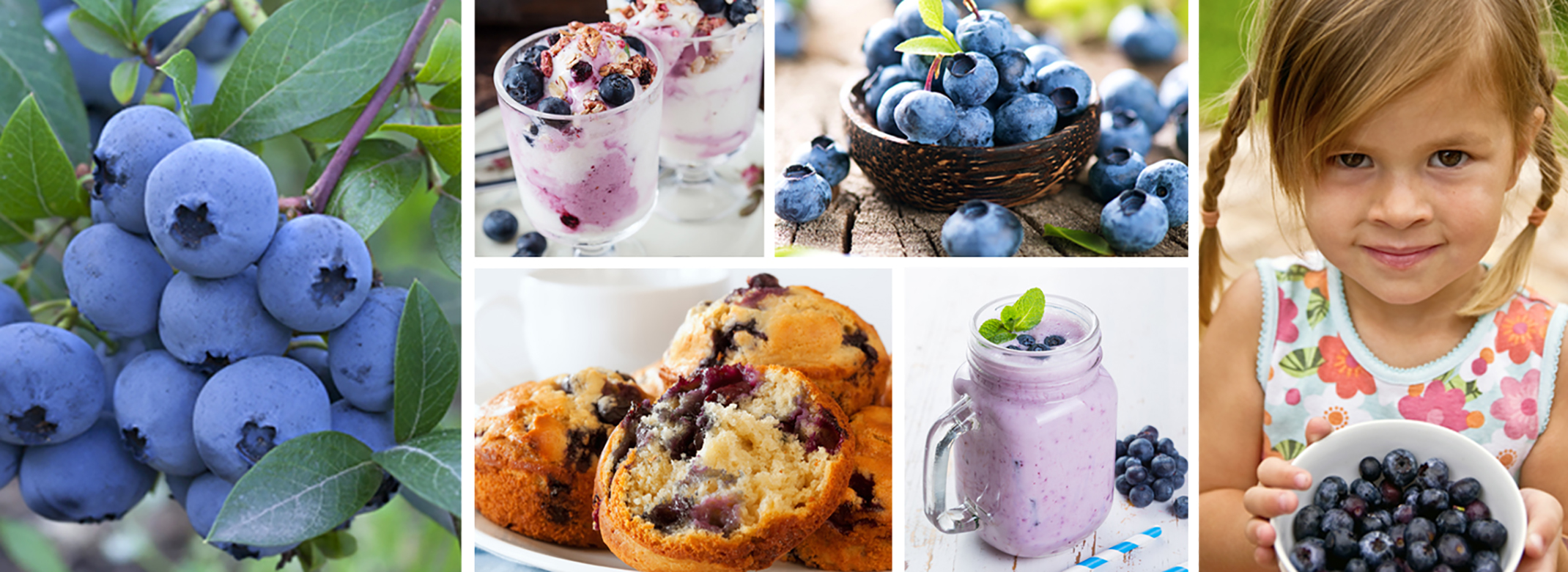
For The Love Of Blueberries
Blueberry bushes are quite easy to grow and can bear fruit for over 15 years. They are tough against pests and diseases. Like their relatives, rhododendrons and azaleas, blueberries love acidic soil and add beauty to your California garden. While they can pollinate themselves, planting multiple varieties will give you more and bigger berries and can lengthen the picking time. Plus, they're delicious and packed with antioxidants, supporting brain and heart health.
- NEW! - 5 Southern Highbush Blueberries - Four Winds Growers
- Bountiful Blue® Blueberry - Monrovia@
- Planting Blueberries in Containers
- Planting Blueberries in Ground
- Watering & Feeding Your Blueberries
Please note that not all varieties may be available at all locations. See your local SummerWinds for availability.

5 Southern Highbush Blueberries - All Self-Fertile
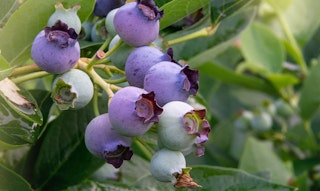
Sunshine Blue Blueberry
Garden Interest:- Compact growth habit, self-fertile, makes it ideal for smaller gardens or growing in containers.
- Blue-green leaves turn red in cold weather. Bright pink flowers bloom in spring before the fruit.
- The berries are medium, blue, and sweet-tart. They're firm, great for eating raw or cooking.
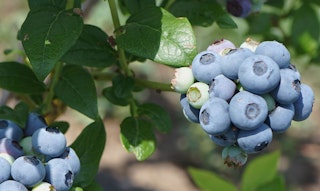
Sharpblue Blueberry
Garden Interest:- An upright, tall bush with glossy green leaves, which makes a great hedge plant.
- Flowers in early to mid-spring with small, bell-shaped white or pinkish flowers that attract pollinators.
- Each bite of these large blueberries bursts with outstanding flavor and is of excellent quality.
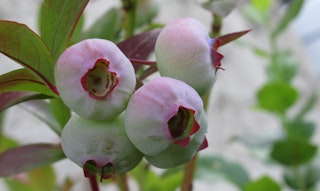
Jewel Blueberry
Garden Interest:- The plant has thick, shiny green leaves that look great in gardens and change to bright red and yellow in autumn.
- Grows pretty white or light pink flowers in spring that attract bees and butterflies.
- Big, sturdy, and sweet, they are perfect for snacking, cooking, and jam-making. They turn a rich blue when ready to eat.
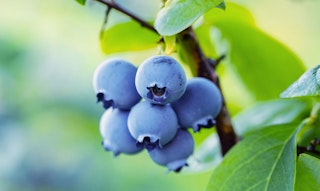
Misty Blueberry
Garden Interest:- Appreciated for its ornamental value, foliage can turn to hues of red and yellow in the fall adding seasonal interest.
- Has a tall and wide growth, ideal for hedges or garden focal points.
- Berries are large and are both sweet and tangy making them excellent for both fresh consumption and culinary use.
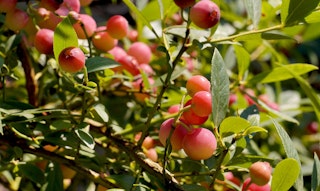
Pink Lemonade Blueberry
Garden Interest:- Exhibits a uniform, compact growth habit that produces mid-summer fruit with a captivating pinkish-red hue.
- Distinctive Taste: Bears uniquely colored, pink-blushed lemon-yellow berries that are both juicy and firm, offering a balanced blend of sun-kissed sweetness and a refreshing lemon tang.
These are hybrids of blueberries which grew wild when European settlers first arrived in the New World. New Southern Highbush cultivars were developed to grow in California and other climates with low chill hours. Blueberry plants make an excellent addition to edible landscapes. They have dark blue green foliage and attractive pink or white blooms. - Four Winds Growers
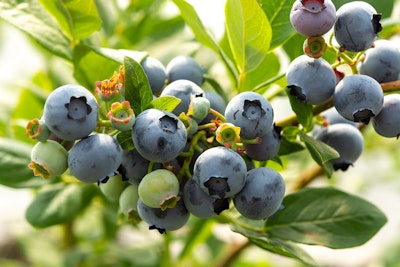
Bountiful Blue® Blueberry
Vaccinium corymbosum
This prize-winning selection from Monrovia® boasts the deepest blue foliage! Its flowers, kissed with pink, yield an abundant harvest of sizeable, succulent, and flavorful berries, all from a neatly compact, mound-shaped shrub. Ideal for creating hedges or for container gardening in spacious tubs. While it is self-pollinating, pairing it with another variety could enhance its fruit production.
- Monrovia®
- Needs only 150-200 winter chill hours.
- Semi-evergreen in mild climates.
- Moderate growing; reaches 3 to 4 ft. tall and wide.
Blueberry Care
Planting Blueberries in Containers
To achieve the best control over soil conditions, planting in containers is highly advised. Ensure the potting mix is acidic (pH 4.5-5.5), rich in organic material, and facilitates good drainage.
For blueberries in containers, select a potting mixture that drains efficiently and is abundant in organic content. It's wise to steer clear of terra cotta pots since they can draw moisture away from the plant. Planting blueberries closely is beneficial, and it is strongly recommended to grow at least two different varieties together to enhance pollination.
source: Monrovia® | Grow BeautifullyPlanting Blueberries in Ground
Blueberries thrive either in the ground or in containers, provided they receive full sunlight, adequate airflow, and are in soil with a pH of 4.5-5.5. For in-ground planting, prepare a hole 24 inches in diameter and at least 12 inches deep, enriching it with compost, peat moss, and a high-quality potting mix suited for acid-loving plants. This combination of soil amendments will help retain the right level of moisture and foster soil vitality by attracting beneficial insects and fungi. It's crucial not to mix fertilizers into the soil at the time of planting or when filling in around your blueberries.
Watering Blueberries
Blueberries demand a higher water intake compared to many other plants in the garden, necessitating consistently moist soil. They are intolerant to drought conditions, thus regular watering is essential. The frequency and volume of watering largely hinge on your local weather conditions, but the goal is to maintain uniformly moist soil. A minimum of once a week should suffice to keep the soil adequately moist, though you should pause watering for a few days following rainfall. During watering sessions, it's important to direct water to the soil rather than the leaves, as wet foliage can lead to fungal disease development.
Fertilizing Blueberries
Blueberries flourish with acid-based fertilizers, like those intended for Azaleas, but it is crucial to avoid nitrogen in nitrate form.
Given their sensitivity to over-fertilization, selecting the right product is key. E.B. Stone Organics Azalea, Camellia & Gardenia Food is an excellent choice for nurturing both potted and in-ground blueberry plants. Start applying this fertilizer in early spring and continue as directed on the packaging throughout the growing season. While fertilizers designed for camellias, rhododendrons, and azaleas are beneficial for blueberries, it’s important to apply them sparingly to avoid harming the plants, as they do not require a large amount of feed. Fresh manures should be avoided.
To prevent over-fertilization, halt fertilization by October or when cooler fall weather begins, and resume in spring after the blueberries have leafed out, typically around March 15.
Blueberries are very sensitive to over-fertilization. Stop fertilizing by October, or the time of onset of cooler fall weather. Resume fertilizing in spring after blueberries have leafed out (around March 15).
Provide rich, acidic, well-drained soil. Water deeply and regularly during first growing season to establish an extensive root system. In extremely hot, arid summer areas, best with some shelter from harsh, reflected afternoon sun. Before new growth begins, prune off twiggy growth, leaving only main stems to prevent overbearing.
Looking to add fresh, homegrown blueberries to your garden? We’ve got you covered! From selecting the best variety to expert care tips, our team is here to help you cultivate a thriving blueberry harvest.

